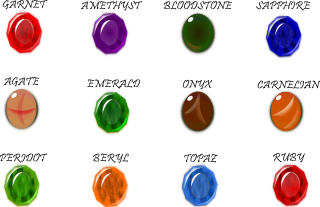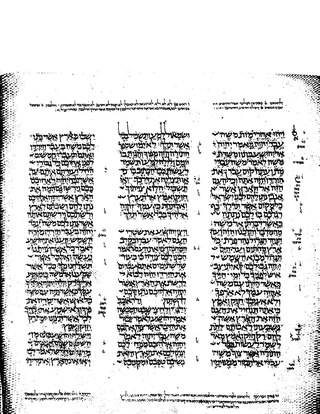
Joshua, also known as Yehoshua, Jehoshua, or Josue, functioned as Moses' assistant in the books of Exodus and Numbers, and later succeeded Moses as leader of the Israelite tribes in the Book of Joshua of the Hebrew Bible. His name was Hoshea the son of Nun, of the tribe of Ephraim, but Moses called him "Yehoshua", the name by which he is commonly known in English. According to the Bible, he was born in Egypt prior to the Exodus.

Lapis lazuli, or lapis for short, is a deep-blue metamorphic rock used as a semi-precious stone that has been prized since antiquity for its intense color. Originating from the Persian word for the gem, lāžward, lapis lazuli is a rock composed primarily of the minerals lazurite, pyrite and calcite. As early as the 7th millennium BC, lapis lazuli was mined in the Sar-i Sang mines, in Shortugai, and in other mines in Badakhshan province in modern northeast Afghanistan. Lapis lazuli artifacts, dated to 7570 BC, have been found at Bhirrana, which is the oldest site of Indus Valley civilisation. Lapis was highly valued by the Indus Valley Civilisation. Lapis beads have been found at Neolithic burials in Mehrgarh, the Caucasus, and as far away as Mauritania. It was used in the funeral mask of Tutankhamun.

According to the Hebrew Bible, the tabernacle, also known as the Tent of the Congregation, was the portable earthly dwelling of God used by the Israelites from the Exodus until the conquest of Canaan. Moses was instructed at Mount Sinai to construct and transport the tabernacle with the Israelites on their journey through the wilderness and their subsequent conquest of the Promised Land. After 440 years, Solomon's Temple in Jerusalem superseded it as the dwelling-place of God.

Hyacinth or Hyacinthus is a deified hero and a lover of Apollo in Greek mythology. His cult at Amyclae southwest of Sparta dates from the Mycenaean era. The hero is mythically linked to local cults and identified with Apollo. In the Classical period, a temenos (sanctuary) grew up around what was alleged to be his burial mound, which was located at the feet of a statue of Apollo.

The priestly breastplate or breastpiece of judgment was a sacred breastplate worn by the High Priest of the Israelites, according to the Book of Exodus. In the biblical account, the breastplate is termed the breastplate of judgment, because the Urim and Thummim were placed upon it. These elements of the breastplate are said in the Exodus verse to carry the judgment of God concerning the Israelites at all times.

The Ten Commandments, or the Decalogue, are religious and ethical directives, structured as a covenant document, that, according to the Hebrew Bible, are given by YHWH to Moses. The text of the Ten Commandments was dynamic in ancient Israel and appears in three markedly distinct versions in the Bible: at Exodus 20:2–17, Deuteronomy 5:6–21, and the "Ritual Decalogue" of Exodus 34:11–26.

The pygarg is an animal mentioned in the Bible in Deuteronomy 14:5 as one of the animals permitted for food. The Septuagint translates the Hebrew yachmur (יחמור) as pygargos in Koiné Greek, and the King James Version takes from there its term pygarg.
In the Bible, the abyss is an unfathomably deep or boundless place. The term comes from the Greek word abyssos, meaning "bottomless, unfathomable, boundless". It is used as both an adjective and a noun. It appears in the Septuagint, which is the earliest Greek translation of the Hebrew Bible, and in the New Testament.

A birthstone is a gemstone that represents a person's birth period, usually the month or zodiac sign. Birthstones are often worn as jewelry or a pendant necklace.
A range of gemstones are mentioned in the Bible, particularly in the Old Testament and the Book of Revelation. Much has been written about the precise identification of these stones, which has ranged from speculative to increasingly scientific with the advent of archeogemology.

Revelation 12 is the twelfth chapter of the Book of Revelation or the Apocalypse of John in the New Testament of the Christian Bible. The book is traditionally attributed to John the Apostle, but the precise identity of the author remains a point of academic debate. This chapter contains the accounts about the woman, the dragon, and the child, followed by the war between Michael and the dragon, then the appearance of the monster from the sea. William Robertson Nicoll, a Scottish Free Church minister, suggests that in this chapter the writer has created a Christianised version of a Jewish source which "described the birth of the Messiah in terms borrowed from ... cosmological myths [such as] that of the conflict between the sun-god and the dragon of darkness and the deep".

Revelation 5 is the fifth chapter of the Book of Revelation or the Apocalypse of John in the New Testament of the Christian Bible. The book is traditionally attributed to John the Apostle, but the precise identity of the author remains a point of academic debate. This chapter contains the inaugural vision of the lamb on the throne in heaven.

Revelation 9 is the ninth chapter of the Book of Revelation or the Apocalypse of John in the New Testament of the Christian Bible. The book is traditionally attributed to John the Apostle, but the precise identity of the author remains a point of academic debate. In this chapter, the next two angels' trumpets are sounded, following the sounding of the first four trumpets in chapter 8. These two trumpets and the final trumpet, sounded in chapter 11, are sometimes called the "woe trumpets".

Revelation 15 is the fifteenth chapter of the Book of Revelation or the Apocalypse of John in the New Testament of the Christian Bible. The book is traditionally attributed to John the Apostle, but the precise identity of the author remains a point of academic debate. This chapter includes the hymn of Moses and the Lamb and introduces the seven angels who appear with seven plagues.

Revelation 18 is the eighteenth chapter of the Book of Revelation or the Apocalypse of John in the New Testament of the Christian Bible. The book is traditionally attributed to John the Apostle, but the precise identity of the author remains a point of academic debate. This chapter describes the fall of Babylon the Great.

Revelation 20 is the twentieth chapter of the Book of Revelation or the Apocalypse of John in the New Testament of the Christian Bible. The book is traditionally attributed to John the Apostle, but the precise identity of the author remains a point of academic debate. This chapter contains the notable account of the "Millennium" and the judgment of the dead.

Revelation 22 is the twenty-second and final chapter of the Book of Revelation or the Apocalypse of John, and the final chapter of the New Testament and of the Christian Bible. The book is traditionally attributed to John of Patmos. This chapter contains the accounts of the throne of God in the New Jerusalem, the conversation between John and the Angel and the epilogue of the book.

Ezekiel 1 is the first chapter of the Book of Ezekiel in the Hebrew Bible or the Old Testament of the Christian Bible. This book contains prophecies attributed to the prophet/priest Ezekiel, and is one of the Books of the Prophets. In the New King James Version, this chapter is sub-titled "Ezekiel’s Vision of God", and in the New International Version, "Ezekiel’s Inaugural Vision". In the text, the first verse refers to "visions" (plural).

Joshua 4 is the fourth chapter of the Book of Joshua in the Hebrew Bible or in the Old Testament of the Christian Bible. According to Jewish tradition the book was attributed to Joshua, with additions by the high priests Eleazar and Phinehas, but modern scholars view it as part of the Deuteronomistic History, which spans the books of Deuteronomy to 2 Kings, attributed to nationalistic and devotedly Yahwistic writers during the time of the reformer Judean king Josiah in 7th century BCE. This chapter focuses on the Israelites crossing the Jordan River westward into the land of Canaan under the leadership of Joshua, a part of a section comprising Joshua 1:1–5:12 about the entry to the land of Canaan.















